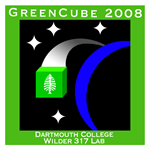
|
Main /
LaunchlistTimeline of GreenCube's past launches June 3, 2008: GreenCube 0 a dummy payload containing only GPS and radio systems, which demonstrated the group's ability to launch, track, and recover
November 20, 2008: GreenCube 1 a full systems flight test with a magnetometer and 6 thermistors as sensors
August 25, 2009: GreenCube 2 investigation of gravity waves over Mt. Washington using temperature and GPS data. This was the first mission using two main payloads, Henry and Fred, on two balloons.
July 27, 2010: GreenCube 3 telescope tracking of the payload using real time GPS data. First use of DNT radios and despinning bar.
May 1, 2011: GreenCube 3A single-balloon repeat of GreenCube 3, with the addition of an iPhone attached to the payload also collecting data. The group was joined by Isaac Shivvers of Harvard, who worked with us on developing the telescope tracking system.
September 2, 2011: ALTAIR 0 flight systems test and tree climbing practice
April 13, 2012: ALTAIR 1 continued flight systems testing (and tree climbing)
May 12, 2012: DUCKS 0 17 Arduino-based payloads equipped with GPS, magnetometer, accelerometer, and xbee radio, housed in tupperware. The ducks were floated down the Connecticut River with the objective of mapping river flow and vorticity.
May 19, 2012: DUCKS 1 Ompompanoosuc launch, similar to DUCKS 0. First time the group did not recover a launched payload (Ozzy)
July 14, 2012: GreenCube 4 (Dave I) Test of the Arduino Uno R3 control board (replacing K111), new GPS module and home-built solar panel in a 3U payload. DNT reception was lost by both the launch and the recovery teams on the same packet number, suggesting (along with internal thermistor data) that the Arduino battery got too cold.
September 16, 2012: GreenCube 4 (Dave II) Similar to Dave I, but with new, non-altitude-limited GPS module and hinged foam enclosure, onboard SD card and Yagi antennas for both groundstations. Arduino powercycled regularly, rendering packet numbers useless; the ham radio clock was instead used to order the data. DNT LOS at approximately 9 km from launch site. The ELT was not turned on for the launch, but the recovery team was able to receive ham data (including GPS) for the entire downleg, allowing quick location of the payload on the ground.
May 19, 2013: GreenCube 5 (Dave-Bob) The Bob small rocket payload was modified to fit the Dave housing for sounding balloon flight, and was the first balloon test of the BobShield. The photometers and thermistors (except ham radio thermistor) were removed from the sensor package for this flight. The launch team received ham and DNT data for almost the entire flight, until LOS at ~20,000 ft on the downleg; the recovery team received ham and DNT data until ~7,000 ft, and was able to locate the payload quickly using the last GPS fix and ELT. Regular dropouts in DNT data suggest the Arduino was powercycling during the flight.
|